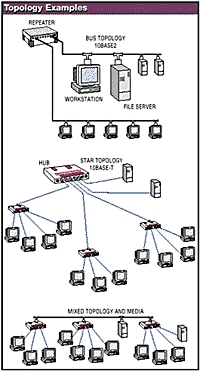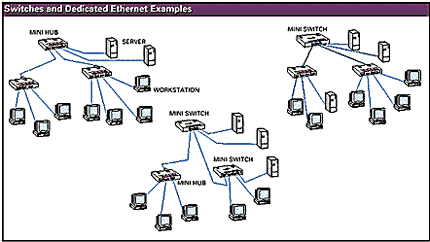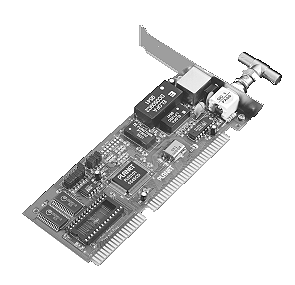1.0 Introduction
1.1 Cables
and Networks
1.1.1 Cables
1.2
Devices
1.2.1 Repeater
1.2.2 Bridge
1.2.3 Router
1.3
Ethernet Topology
1.4
CSMA/CD
1.5
Network (Interface) Cards
2.0 Topologies and Internet Protocol
2.1 IP
Address
Multiple choice questions (solutions)
Appendix Books and References in the
Internet
In this article we discuss Ethernet (IEEE 802.3 standard),
which is the most popular way to build a LAN (Local Area Network)
today. There are other LAN types like Token Ring, Fast Ethernet (IEEE
802.3u), FDDI (Fiber Data Distributed Interconnect), LocalTalk or ATM
(Asynchronous Transfer Mode).
| Ethernet Network | Topology | Cables, Plugs and other components | Speed |
| 10Base-T, 100Base-T | star, peer-to-peer | Unshielded Twisted Pair, RJ45 (Registered Jack) | 10Mbps or 100Mbps |
| 10Base-2 (internet-link) |
bus | 10Mbps maximum | |
| 10Base-5 | bus | Yellow Cable = thick coax = Thickwire, Transceiver, Terminator | 1, 2, 5 or 10Mbps |
| 10Base-F | fiber optic | 10Mbps |
| Ethernet Network | special features | Max Segment (meters) | Nodes per Segment |
| 10Base-T, 100Base-T | easy maintenance, very reliable (one fault
usually doesn`t affect the entire network); relatively short distances between devices (100m), requires a lot of wiring (a seperate link for each workstation) |
100m between devices | 1024 |
| 10Base-2 (linternet-link) |
cheap (no devices - swiches, ... - between hosts
required), well shielded against electrical interference, can transmit
longer distances (200m); any break in connectivity disrupts entire network segment, problems can be very difficult to troubleshoot |
185-200m | 30 |
| 10Base-5 | old technic | 500m | 100 |
| 10Base-F | between buildings, immune to electrical
interferences, long distance networking (2000m); very expensive to install |
2000m | 1024 |
The notation 10Base-5 for example means that it operates at 10 Mbps,
uses baseband signaling and can support segments of up to 500 meters.
The most interesting network type is the 10/100Base-T network
because it`s the most used one. The "T" in 10BASE-T stands for "twisted"
in reference to the twisted-pair cable.
| twisted-pair cable: | There are always two isolated copper wires twisted with each other in order to improve resistance against electrical interferences. |
| straight cable: | The order of the pins is the same at
both plugs. Used to connect two different device types. |
|
crossed cable: |
The order of the pins is not the
same at both plugs (pins for sending and receiving are exchanged). Used to connect two devices of the same type. |
| shielded: | There is a protection around each
wire pair. Provides higher bandwidth. |
| unshielded: | Without any protection. |
There are also some combinations of these types available. For
example:
- UTP (unshielded twisted pair)
- STP (shielded twisted pair)
![]() -->show/hide
typical Ethernet (RJ45) Plug (www.cyberwalker.net/connectors/
images/network-plug.jpg)
-->show/hide
typical Ethernet (RJ45) Plug (www.cyberwalker.net/connectors/
images/network-plug.jpg)

![]() --> RJ45 connectors look (almost!) like
phone connectors (help.exeter.edu/ITImages/)
--> RJ45 connectors look (almost!) like
phone connectors (help.exeter.edu/ITImages/)
![]() --> a PCMCIA card for laptops with plugs
(connectors) for both, coaxial and RJ45 cables (http://www.lll.uiuc.edu/g8/laptop/images/lancard_cable.jpg)
--> a PCMCIA card for laptops with plugs
(connectors) for both, coaxial and RJ45 cables (http://www.lll.uiuc.edu/g8/laptop/images/lancard_cable.jpg)
1.2 Devices![]()
To give an overview, the following list contains the most important
devices which can get connected:
- PCs
(Servers, Hosts, Workstations)
- Network
(Interface) Card (NICs)
- Hubs
- Switches
- Bridges
-
Switching Hubs
- Routers
-
Repeaters
Each device has its own place in the network topology and therefore its
own task in the network.
1.2.1 Repeater
A repeater works on layer 1 of the ISO/OSI reference model. It
regenerates the signal before sending it to the port. There are also
often used multi-port repeaters, which are not very intelligent - it
passes forward all received packets to all ports.
For example in 10Base2-Networks no repeaters were used, but the hosts
were connected in a row and it was difficult to detect cable breaks.
10BaseT Networks which are using repeaters allow us to find cable
breaks immediately.
1.2.2 Bridge
A bridge works on layer 2 of the ISO/OSI reference model to connect two
network segments together. There are also commonly used multi-port
Bridges, which are often called switches.
A bridge is more intelligent than a repeater. That means that the
bridge knows the connected devices and sends the received packets only
to the right port.
1.2.3 Router
A Router works on layer 3 of the ISO/OSI reference model.
In difference to Repeaters and Switches, Routers do actively filter
incoming data before passing them forward.
1.3 Ethernet Topology ![]()
Ethernet networks are the most commen used networks for LANs (local
area networks). An Ethernet is normally built with copper cables. The
topologies of 10Base-T Ethernet networks look very much like trees.
The next picture will show some example configurations.
![]() --> show/hide Topology Examples
--> show/hide Topology Examples


The CSMA/CD (carrier sense multiple access with collision detection)
mechanism is often used in todays Ethernets. CSMA/CD is a
nondeterministic access method. An example of the sending process:
The station which wants to send, first checks the momentanous network
activities (Carrier Sense). If it detects activities from other
stations, it waits. If there is no activity on the network, the
station begins to send after a defined waiting time. Afterwards the
station checks the medium for a predefined time. If it sees, that its
transmission has had a collision with another transmission of another
sender, it stops the own transmission and sends a so called
'Jam-Signal' to inform all other stations about the collision. After a
random period of time the stations begins to send again in the same
way as before.
A random period of time is important. Otherwise two stations could send
permanently at the same time and collisions would be predetermined.
![]() --> show/hide example of a Network Interface Card
(Nic)
--> show/hide example of a Network Interface Card
(Nic)

example
NIC with BNC T Adaptor
(http://www.usbcable.com/networking/29-7785.htm">http://www.usbcable.com/networking/29-7785.htm)
When you are joining two different nets with the help of a router, it's important that both nets have different net-IDs.
You may also think that the address is devided in only two parts, which will make it sometimes easier to understand; especially when the address is in decimal form. Then the class bits would be a part of the "beginning bits" (bits before the host-ID), and these bits can be always written as x, x.x, x.x.x or x.x.x.x in decimal form.
IP-Address:
|
class bits (1 up to 4 bits)
|
net-ID
(7, 14 or 21 bits)
|
host-ID
(24, 16, or 8 bits)
|
|
"beginning bits" (x, x.x, x.x.x
or x.x.x.x)
|
host-ID (x.x.x, x.x, x or -)
|
Examples:
|
decimal
|
binary (class-bits,net-ID-bits
and host-ID-bits)
|
class
|
number of net-ID bits /
host-ID bits
|
|
44.123.110.224
|
00101100 01111011
01101110 11100000
|
A
|
7 / 24
|
|
129.6.48.100
|
10000001
00000110 00110000 01100100
|
B
|
14 / 16
|
|
128.240.1.109
|
10000000
11110000 00000001 01101101
|
B
|
14 / 16
|
The address-class determines the
possible valid beginning-part of the address:
|
address class
|
class bits
|
number of net-ID bits /
host-ID bits
|
maximal number of nets (or
net-numbers)
|
maximal number of host for one
net (or net-number)
|
first valid value for the
beginning-part of the IP-address (class bits and net-ID bits)
|
last valid value for the
beginning-part of the IP-address (class bits and net-ID bits)
|
|
A
|
0
|
7 / 24
|
126 (27-2)
|
16.777.214 (224-2)
|
1
|
126
|
|
B
|
10
|
14 / 16
|
16.382 (214-2)
|
65.534 (214-2)
|
128.1 (128=10000000)
|
191.254 (191 = 10111111)
|
|
C
|
110
|
21 / 8
|
2.097.150 (221-2)
|
254 (28-2)
|
192.0.1
|
223.225.254
|
|
D
|
1110
|
-
|
|
|
224.0.0.0
|
239.255.255.254
|
|
E
|
1111
|
-
|
|
|
240.0.0.0
|
255.255.255.254
|
Internet-Links